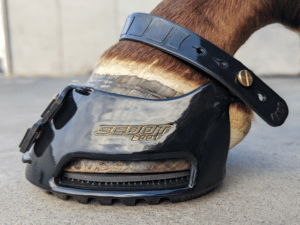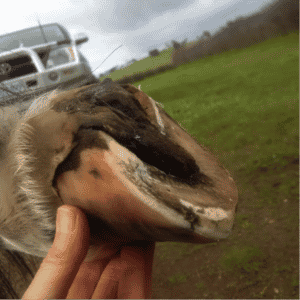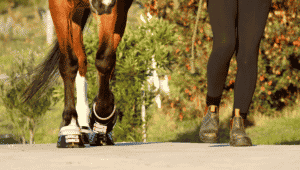According to the Australian Certified Equine Hoofcare Practitioners ACEHP, hoof boots are a vital part of the action plan that should be initiated immediately when your horse is diagnosed with laminitis. We will explore why hoof boots are an essential aid in laminitis recovery and gain insight into other parts of the professional hoof trimmer’s emergency laminitis hoof care.
Laminitis is an immensely painful disease and any horse can get it – including skinny horses and horses that are exercised regularly. In fact, laminitis is one of the biggest killers in the world of domestic horses and any signs of laminitis in your horse should always be taken seriously and treated as an emergency.
Just how quickly the vicious disease can turn from subtle to severe, was recently witnessed by Angie Howard from Stepping Stone Equine Hoof Care. During a showjumping training session, one of her clients’ horses, Byron, suddenly refused to move forward, and the owner Chloe Lyon was quick to check his digital pulse for signs of laminitis:
“Chloe then called me in distress saying something was completely wrong with Byron. I was able to go see him the following day and immediately put him in padded hoof boots. Only that didn’t help him enough, and as the vet couldn’t come to do x-rays till the day after, I decided to perform an emergency trim by removing the hoof wall at the toe to relieve the pressure,” Angie said.
Angie’s decision turned out to be exactly right, as the x-rays on the following day showed the laminae starting to detach from the pedal bone, which had already caused the pedal bone inside the hoof to start rotating down towards the ground. As such, in only three days from the first sign of foot soreness, the laminitis could have caused irreversible damage to the young showjumper, if correct action hadn’t been taken immediately.
Showjumper Byron and his talented young rider Aggie. Aggie and her mum Chloe Lyon had attended a talk by Angie Howard at their pony club about recognizing signs of laminitis, which enabled them to act promptly when Byron suddenly didn’t act as normal.
First Step in a Laminitis Emergency: Remove the Cause
The laminae is the tissue that holds the pedal bone, also called the coffin bone, in place inside the horse’s hooves. When it becomes inflamed and starts breaking down, it can no longer hold the pedal bone in position and the weight of the horse will cause the pedal bone to be pushed down through the sensitive tissues and eventually break through the sole of the hoof. It takes no science degree to imagine how immensely painful this is to the horse.
Laminitis is a mystery that still hasn’t been fully depicted despite continuous research across the world. There is, however, enough evidence to determine a number of factors that can put your horse in great risk of developing laminitis. Some of these include:
- Overfeeding carbohydrates such as cereal grains, molasses and fruit
- Pastures high in carbohydrates and especially when there are sudden spouts of new growth as in springtime and after a night of frost, as the grass then contains the highest amount of sugars
- Overweight horses are at great risk of laminitis due to the metabolic consequences of obesity
- Horses who are insulin resistant (EMS) or has Cushing’s Disease are at high risk of developing laminitis
- Horses who are under stress from excessive traveling, overtraining or illness are also at risk of a sudden laminitis attack
If you notice any signs of laminitis in your horse but aren’t sure of the cause, Angie Howard’s rule of thumb is to immediately remove the horse from pasture and stop feeding any grains or other sugary feed stuff completely. Instead, feed your horse low sugar hay or soak your hay thoroughly for at least an hour to wash out the sugars before feeding it. And then you call your vet.

X-ray of Byron’s right front foot showing how the pedal bone has started slipping downwards due to inflammation of the laminae, that would normally keep it in place.
Second Step in Laminitis Recovery: Get your Horse Comfortable in Hoof Boots
After removing your horse from pasture and calling your vet, it’s time to help your horse become as comfortable as possible on thier sore feet. Whether you have put them in a stall or a grass free yard, provide them with some soft, thick bedding to rest in. Next, you get your hoof boots out and insert extra pads inside the boots before putting them on your horse.
If you don’t have hoof boots already, you can use whatever you have at hand like a couple of layers of yoga foam mats that you can cut to size and attach to the hooves with duct tape. Then when your hoof care professional comes, she can help you source a lasting solution in proper hoof boots to aid your horse through his laminitis recovery.
“To be honest, a pair of well fitting, comfortable and softly padded hoof boots are vital in laminitis recovery. Right from very early stages of laminitis to severe, progressed laminitis, padded hoof boots are essential to help keep your horse as comfortable as possible to support their recovery,” Angie said.
According to the ACEHP, hoof boots will protect the recovering sole from all surfaces, reduce concussion, assist healing as there is nothing restricting blood circulation and give your horse the confidence to move comfortable as they start to recover. However, there are many types of hoof boots to choose from and you want to make sure you go with the type of hoof boots that are best suited to aid laminitis and the hoof boots that will assist your horse through all stages of laminitis rehabilitation.

When your horse is sore from laminitis you want to add extra pads inside the hoof boots to make your horse as comfortable as possible.
Hoof Boots from Scoot Boots are Ideal to Support your Laminetic Horse’s Recovery
When choosing the type of hoof boots that are most helpful for your specific purposes, it is useful to identify what your requirements are and what you aim to achieve. For instance, laminitis requires 24/7 pain relieving hoof protection so you would want to avoid fully enclosed types of hoof boots with poor ventilation. Scoot Boots have a low profile and superior ventilation, which makes them perfect for horses that need protection around the clock.
Further, it is important to keep in mind that laminitic horses do not only need protection under the hoof sole, but also relief from any pressure at the toe. Scoot Boots are uniquely designed with an open toe that can even be cut away completely if needed, which makes Scoot Boots the perfect aid for horses with laminitis.
Many hoof boots that are developed for rehabilitation purposes are fully enclosed, heavy and bulky. As such, these types of hoof boots are not ideal to encourage your horse to move as much as possible as his recovery progresses. On the contrary, Scoot Boots are performance boots that are lightweight, flexible and made to encourage correct heel-first landings and confident, comfortable movement across all surfaces.
As such, Scoot Boots can aid your horse’s recovery through all stages of laminitis from the first signs of soreness to supporting new, healthy hoof growth.
Excellent laminitis first aid: Soft surface to rest in, protective and supportive hoof boots from Scoot Boots and safely away from sugary grasses.
The Importance of Professional Hoof Care in Laminitis Rehabilitation
Once you have called your vet, made your horse as comfortable as possible and removed possible causes of laminitis, the vet should be on the way to assess your horse’s symptoms and x-ray his hooves in order to diagnose and determine the degree of laminitis. If at all possible, it would be useful to also have your hoof care professional present for the x-rays, so she can assist with immediate laminitis emergency hoof care.
“I’ll need to see the x-rays to be able to trim at the right angle to match the possible rotation of the pedal bone and in order to know exactly how much of the horse’s toe needs to be trimmed back to relieve the painful pressure. Every case is different and needs to be very carefully assessed in cooperation with the vet”, said Angie, who has years of experience with hoof rehabilitation and is frequently being consulted by vets attending to laminitis emergencies.
Usually in most other hoof rehabilitation cases it is vital to trim very little at the time to not make too radical changes to the hoof too quickly, which could cause worsening of the symptoms or other issues elsewhere in the horse as an attempt to compensate for the new imbalance. However, in the case of a laminitis emergency, it is sometimes necessary to do the opposite and perform a rather drastic trim, which is not something you want an inexperienced trimmer to do.
As such, it is utmost important that you engage a hoof care professional with specific experience in laminitis rehabilitation to make sure your horse gets the right support throughout all stages of recovery and thereby the best chances of successful rehabilitation from laminitis.

The hoof of another laminitis struck horse named Lucy, where Angie Howard performed the emergency trim known as the “toe rocker”, which takes the toe back far beyond what you’d normally do on a sound horse.
Help your Horse Rehabilitate from Laminitis with appropriate Exercise
As we know, movement is one of the most important ingredients in the strong and healthy hoof cocktail. However, when your horse is footsore from laminitis, you need to arm yourself with patience. Your horse should not be forced to move under any circumstances until he chooses to himself, and be careful to not mistake effective pain relief prescribed by your vet with your horse suddenly being pain free.
Depending on the degree of laminitis, your horse could be looking at several weeks of confinement and you should carefully watch for changes in signs of pain when he’s moving. Once he is well enough to move around freely without medical pain relief and physical signs of pain, it could be time to turn him out in a larger yard or take him for short walks at his own pace.
“Never exercise a laminitic horse without padded hoof boots – he’s still recovering and it won’t take much for them to become sore from walking. And always walk them in a straight line, no longing in a round yard or walking around in circles, as the turning will put unnecessary pressure on the angles of the hooves,” Angie said.
Throughout rehabilitation from laminitis and beyond, it is essential to keep up with your new feeding regime and strictly protect your horse from what caused the laminitis, as he will always be prone to laminitis attacks once they’ve first had one.






